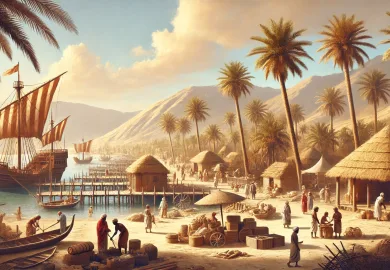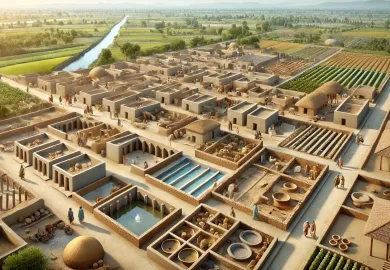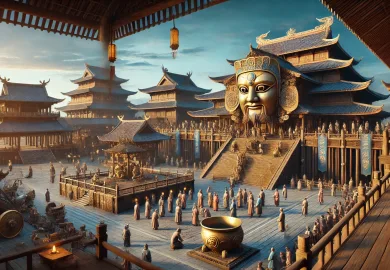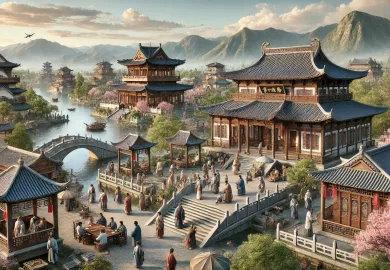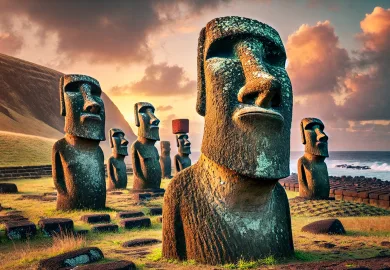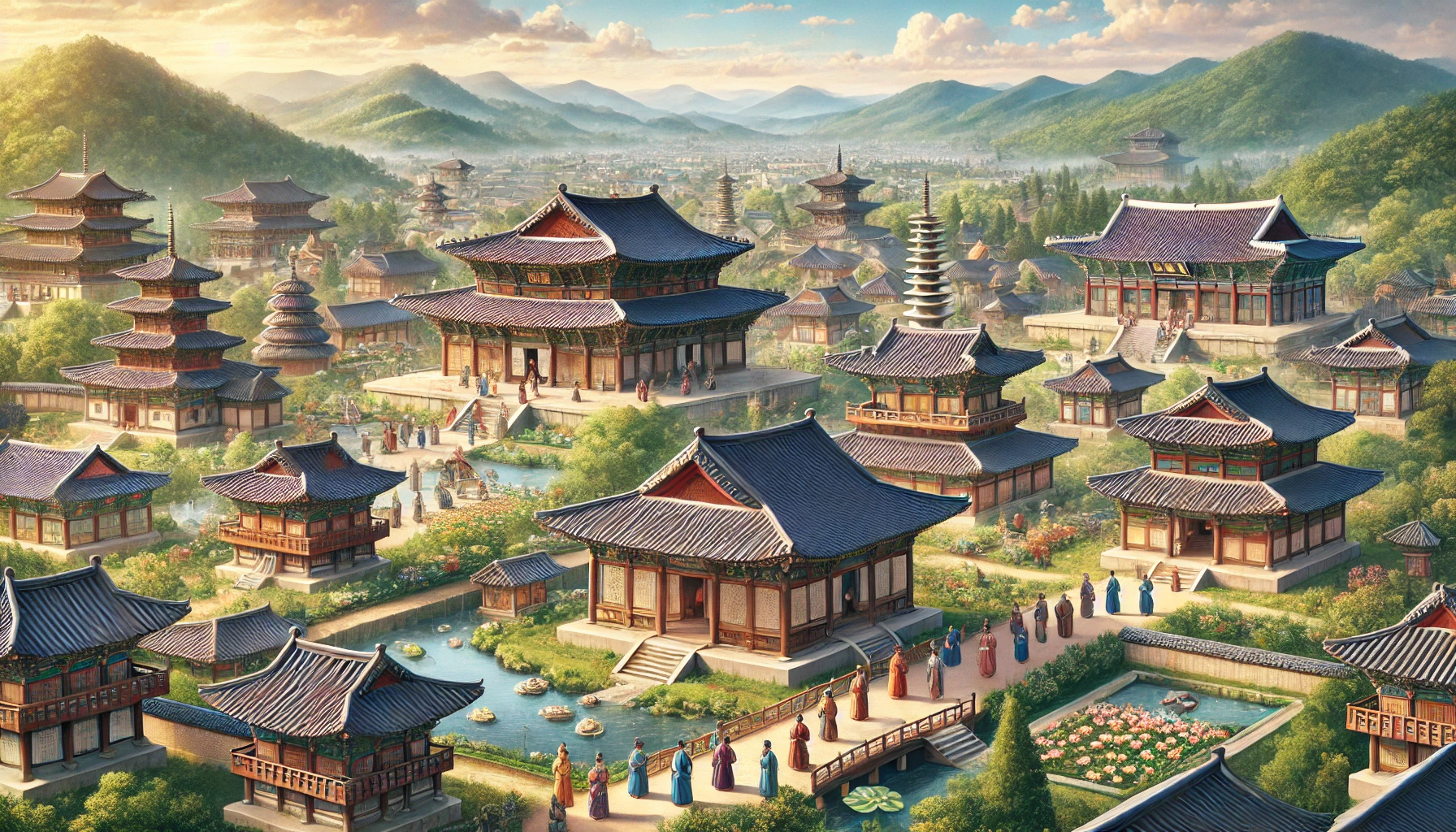
The ancient Silla Kingdom, one of the Three Kingdoms of Korea, is renowned for its profound cultural achievements and unique contributions to the history of East Asia. From its founding in 57 BCE to its unification of the Korean Peninsula in 668 CE, Silla thrived for nearly a millennium. Known for its deep spiritualism, advanced governance, and breathtaking artistry, Silla culture continues to fascinate scholars and history enthusiasts alike. At the heart of the kingdom lay its capital, Gyeongju, a city brimming with architectural marvels, artistic innovations, and spiritual landmarks that testify to the grandeur of this ancient civilization. In this article, we’ll delve into the captivating aspects of Silla’s culture, offering a glimpse into what made it so remarkable.
The Artistic Splendor of Silla: Craftsmanship in Gold and Stone
The Silla Kingdom is often referred to as the “Kingdom of Gold” due to its prolific use of gold in jewelry, crowns, and burial artifacts. Silla artisans were highly skilled in the creation of intricate designs, employing techniques such as granulation, filigree, and inlaying, which can still be seen in the numerous gold artifacts unearthed from royal tombs in Gyeongju.
Silla’s gold crowns, adorned with tree-like protrusions and jade beads, are considered masterpieces of ancient Korean art. These elaborate headpieces symbolized power, spirituality, and the kingdom’s connection to nature. The crowns were often buried with royalty and nobility as a reflection of their divine status and their journey to the afterlife.
Stonework was another key feature of Silla’s artistic landscape. The Seokguram Grotto, a UNESCO World Heritage site, stands as a testament to Silla’s advanced stone-carving techniques. The grotto houses a majestic seated Buddha, surrounded by intricately carved bodhisattvas, disciples, and guardians. This blend of natural and artistic elements reflects the kingdom’s integration of Buddhist ideals with its artistry.
Buddhism’s Role in Shaping Silla Culture
Buddhism played a pivotal role in the spiritual, cultural, and political life of Silla, particularly after it was adopted as the state religion in the 6th century. The kingdom’s embrace of Buddhism not only united its people but also helped forge relationships with neighboring China and Japan, allowing for a rich cultural exchange that influenced Silla’s development.
Silla’s dedication to Buddhism is best exemplified in its grand temples and monasteries. Bulguksa, another UNESCO World Heritage site, is one of the most famous examples of Silla’s religious architecture. Built to embody the ideal Buddhist utopia, the temple’s layout and structures symbolize the journey toward enlightenment. The temple grounds feature beautiful pagodas, stone bridges, and meditation halls, all designed to foster spiritual reflection.
The spread of Buddhism also led to the creation of sacred texts and the commissioning of religious art, including large bronze Buddha statues and stone pagodas. Silla monks were known for their scholarly contributions, producing important texts on Buddhist teachings that were influential across East Asia. This spiritual fervor extended into daily life, with ordinary citizens participating in religious festivals, pilgrimages, and communal rituals that emphasized harmony, compassion, and mindfulness.
Silla’s Government and Society: A Hierarchical Yet Harmonious System
The Silla Kingdom was governed by a rigidly hierarchical system known as the “bone rank” system (Golpumje), which dictated social status, political authority, and even marriage possibilities. At the top were the sacred bone (Seonggol) and true bone (Jingol) classes, which comprised the royal family and high-ranking aristocrats. Below them were various classes of nobility, commoners, and slaves. While the system was strictly enforced, it also ensured that those of high status were well-educated and trained in governance, resulting in a relatively stable and efficient administration.
Silla’s government was centralized under the king, with various ministries and officials responsible for different aspects of state affairs, such as agriculture, military, and foreign diplomacy. The kingdom maintained a disciplined military, which was crucial in its campaigns to unite the Korean Peninsula. Despite its militaristic achievements, Silla is often remembered for the peaceful and prosperous reigns that allowed the flourishing of arts, culture, and spirituality.
Daily life in Silla was also heavily influenced by Confucian ideals, which emphasized loyalty to the state, filial piety, and ethical conduct. Education and scholarship were highly valued, with Confucianism shaping not only governance but also personal behavior and social relations. This blend of Buddhism and Confucianism created a unique cultural harmony in Silla, where religious and secular life were intricately intertwined.
The Unification of the Korean Peninsula: Silla’s Legacy of Diplomacy and Warfare
One of Silla’s most significant achievements was the unification of the Korean Peninsula in 668 CE, marking the first time that Korea was ruled by a single state. The process of unification was long and complex, involving both military conquest and strategic alliances with China’s Tang Dynasty. Silla’s success in unification was largely due to its strong leadership and the skilled diplomacy of its rulers, who managed to outmaneuver both the Goguryeo and Baekje kingdoms.
The kingdom’s military prowess was showcased in numerous battles, but Silla also knew when to use diplomacy to its advantage. The Silla-Tang alliance was pivotal in defeating Baekje and Goguryeo, though this alliance was later tested when Tang sought to establish control over the newly unified territory. Silla successfully resisted Tang’s efforts, ensuring its independence and solidifying its control over the Korean Peninsula.
The unification of Korea under Silla laid the groundwork for the future development of Korean identity and culture. Silla’s influence extended far beyond its borders, impacting trade, diplomacy, and cultural exchanges with Japan, China, and other parts of East Asia. Its legacy continued to shape Korean history long after its fall in the 10th century, with many of its traditions, innovations, and values persisting into modern Korean culture.
In conclusion, the ancient Silla Kingdom was a remarkable civilization that left an indelible mark on Korean history. Through its artistic achievements, spiritual depth, and political innovations, Silla created a cultural legacy that continues to inspire and captivate. Whether it was through their golden artifacts, awe-inspiring temples, or the successful unification of the Korean Peninsula, the people of Silla demonstrated a deep commitment to harmony, enlightenment, and progress—values that resonate to this day.
Warm and Welcoming People
In South Korea, one of the most cherished aspects that visitors frequently remark on is the warmth and hospitality of its people. The locals of South Korea have a deeply rooted tradition of welcoming outsiders with open arms, a practice embedded in the culture for generations. This warm reception goes beyond just friendly smiles; it’s about genuine interest and respect, making tourists feel at home from the moment they arrive.
Whether in bustling cities or quaint rural villages, the people of South Korea are known for going out of their way to make visitors feel comfortable. It’s common for locals to offer directions, share insights about hidden spots, or even invite travelers for a meal. This openness to strangers is not only a mark of respect but also a way to share their culture and heritage, allowing tourists to experience the authentic soul of the country.
This warmth makes a visit to South Korea more than just a journey to a new place; it becomes a memorable experience of human connection. By the end of their stay, many travelers feel they’re leaving not just a beautiful landscape but also newfound friends. It’s this unique combination of natural beauty and heartfelt hospitality that makes South Korea an unforgettable destination, resonating in the memories of everyone who has had the pleasure of experiencing it.


